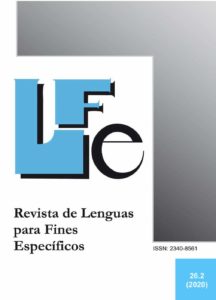[CFP] Revista de Lenguas para Fines Específicos Volume 28.2 (2022)

| Call for papers for special issue
Audiovisual Translation in the Foreign Language Classroom Heather Adams and Jorge Díaz Cintas |
Audiovisual translation (AVT) has been hailed by many as one of the most prolific and fast-growing areas of research in the field of Translation Studies, as the quintessential translation practice of the 21st century. This is hardly surprising in a society like ours, saturated with screens and mediated by the constant presence of moving images, as we draw on audiovisual productions for entertainment, to secure information, to carry out our work, to keep in touch with our peers, to learn and study.
Against this backdrop, the use of AVT in the teaching and learning of (foreign) languages has emerged as a fruitful research avenue. An area of mostly experimental research, foreign-language acquisition and learning via AVT has been expanding at a very fast pace in recent years, with many scholars outlining ways in which various AVT practices (e.g. subtitling, dubbing, audio description, and so on) can be of benefit in foreign-language classrooms. Such a development contrasts sharply with educational paradigms, such as the communicative approach, whereby emphasis is placed on exclusive use of the foreign language in the classroom, de facto shunning the use of translation, and leading Duff (1989: 5) to decry: “translation has been generally out of favour with the language teaching community. (Almost, we might say, ‘sent to Siberia’!)”.
After being considered of little communicative power in foreign language classrooms for several years, translation, and, in this specific instance AVT, has definitely found its footing in second language acquisition after the turn of the century. Activities such as producing subtitles for one’s favourite TV series, dubbing a famous actor into another language or making a video accessible to friends with sensory impairments can not only be arresting and motivating for students, they are also an inviting way to improve on the four foundational skills of language learning: reading, writing, speaking and listening. The honing of transferable skills, thanks to the learners’ exposure to digital technology and different file formats (text, video, subtitles), as well as the practice of translation as a mediating and intercultural activity, also contribute to the educational added value of the various AVT practices.
For this special issue, we invite contributions that reflect on the intersections between audiovisual translation and foreign language teaching and learning. Potential topics include, but are not restricted to, the following:
- Experimental studies into the role of subtitling, dubbing and audio description in the foreign language classroom;
- targeting AVT as a resource for the teaching and learning of foreign languages in specific domains;
- monolingual and bilingual subtitles;
- insights into AVT as a passive and/or active learning resource;
- methodological considerations related to experimental studies in AVT for language learning;
- students’ reception and perception of AVT productions: subtitling, dubbing, audio description, etc.;
- technologies used in AVT and their potential role in the foreign language classroom.
We welcome contributions of full-length papers of between 6,000 and 8,000 words (including endnotes and references). All accepted contributions will be double blind peer-reviewed.
To propose a paper, please send your abstract (max. 500 words including references) to both editors of the special issue, with the subject line LFE 28(2)
Heather Adams: heather.adams@ulpgc.es
Jorge Díaz Cintas: j.diaz-cintas@ucl.ac.uk
PUBLICATION SCHEDULE:
4 May 2021 Deadline for submission of abstracts
25 May 2021 Contributors notified of acceptance of abstracts
15 November 2021 Submission of paper
November 2021– Peer-review of paper
February 2022
February 2022 Notification of provisional acceptance of papers
March-May 2022 Submission of final versions of papers
June-September 2022 Final editing and proofreading
December 2022 Publication
